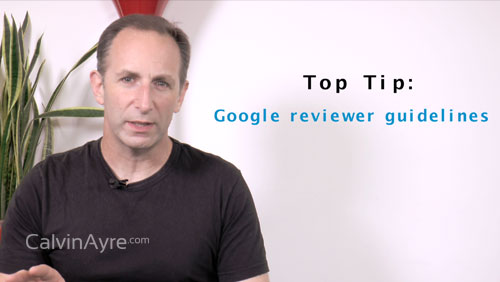90 Digital CEO Nick Garner talks about Google Reviewer Guidelines in this edition of CalvinAyre.com’s SEO Tip of the Week.
It’s important to know how Google are thinking when it comes to rating site quality so with this new document leak we know the answer!
The 2014 leaked Google reviewer guidelines are one of the most important documents in SEO to surface this year. They give the reader a really clear outline of what Google’s manual reviewers have to do when judging a site for quality.
Quality is the important word here because Google is doing its very best to give the highest quality results to the user. What quality means in sort of debatable but in general in the context of Google and their perceptions of what is a good site, you can say it’s all defined here.
Some interesting sections from the document:
2.7 Website Reputation
A website’s reputation is based on the experience of real users as well as the opinion of people who are experts in the topic of the website. Many websites are eager to tell users how great they are. But for Page Quality rating, you must also look for outside, independent reputation information about the website. When the website says one thing about itself, but reputable external sources disagree with what the website says, trust the external sources. Your job is to truly evaluate the Page Quality of the site, not just blindly accept information on one or two pages of the website. Be skeptical of claims that websites make about themselves. Keep in mind that websites often represent real companies, organizations, and other entities. Therefore, reputation research applies to both the website and the actual company, organization, or entity that the website is representing.
Note: Some webmasters have read these rating guidelines and have included information on their sites to influence your Page Quality rating!
2.7.4 How to Search for Reputation Information
3. Look for articles, reviews, forum posts, discussions, etc. written by people about the website. For businesses, there are many sources of reputation information and reviews. Here are some examples: Yelp, Better Business Bureau (a nonprofit organization that focuses on the trustworthiness of businesses and charities), Amazon and Google Product Search. You can try searching on specific sites to find reviews. For example, you can try [ibm site:bbb.org] or [“ibm.com” site:bbb.org].
4.4 Positive Reputation
Reputation is an important consideration when using the High rating. While a page can merit the High rating with no reputation, the High rating cannot be used for any website that has a convincing negative reputation. A very positive reputation can be a reason for using the High rating for an otherwise Medium page.
And on it goes – 160 pages of SEO Gold
My Interpretation: Reputation has nothing to do with number of links from big sites. It’s down to others citing your site and saying good things about it. Interestingly the reviewers will have to use a search engine to find these mentions of in the first place…and this ties into what I always say to clients:
Step 1: Do something well.
Step 2: Build your reputation and get this easily seen on Google.
Step 3: Once your brand is strong, then go for prominence i.e. generic phrases on the search engines.
Getting the document:
You can go here to scribd and read it on their site:
http://www.scribd.com/doc/217994742/General-Guidelines-1
Or you can go here for the actual PDF (thanks CanuckSEO!)
http://canuckseo.com/blog_pdfs/google-quality-rater-guidelines-2014.pdf
There is one other document worth reading; it’s the Panda do’s and don’ts list from the moral concept. It reiterates many of the ideas talked about in the Google reviewer guidelines.






